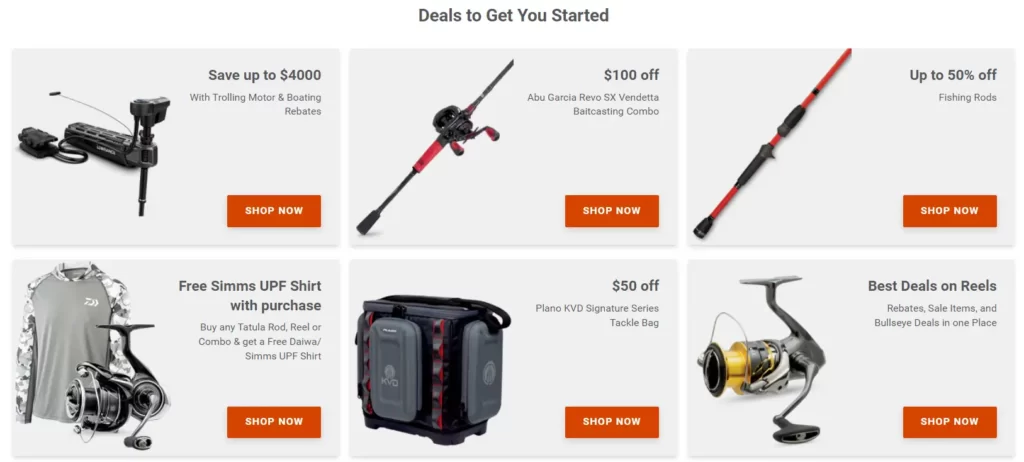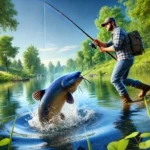Explore Canada's Ultimate Fishing, Hunting, and Wildlife Adventures
Beginner Ice Fishing: Tips for Canadian Anglers
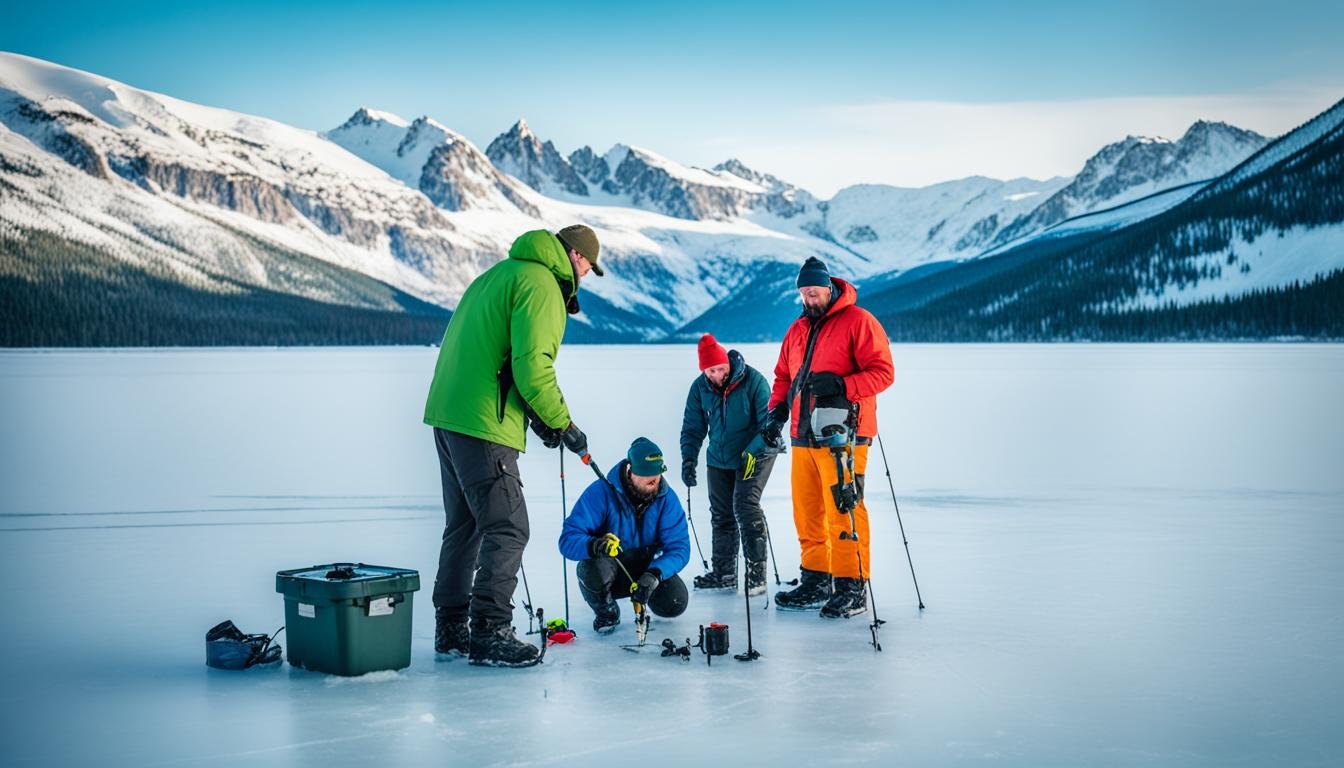
Canadian winters offer a thrilling adventure for ice fishing enthusiasts. This guide will help both seasoned anglers and newcomers master ice fishing in Canada.
Discover how to conquer the frozen landscape and catch fish like a pro. Get ready for an exciting journey into the world of ice fishing!
Key Takeaways about Beginner Ice Fishing
- Discover the joys and challenges of ice fishing in the Canadian winter landscape
- Learn about essential gear and equipment to ensure a safe and productive ice fishing experience
- Explore effective techniques for locating and catching fish through the ice
- Familiarize yourself with crucial safety protocols to protect yourself on the frozen waters
- Uncover the top ice fishing destinations across Canada that offer abundant opportunities for winter anglers
What makes ice fishing such a unique and captivating pursuit for Canadian anglers? This guide will reveal the answers to this intriguing question.
Get ready to experience the thrill of ice fishing in Canada’s frozen wonderland. Let’s explore the secrets of successful winter angling together!
Introduction to Ice Fishing in Canada
Ice fishing is a beloved Canadian tradition. It allows anglers to enjoy the outdoors during winter. The landscape transforms into a stunning frozen wonderland with snow-covered trees and ice-covered lakes.
This winter activity offers a unique experience for all. Anglers of all ages and skill levels can enjoy ice fishing. It’s a rewarding way to spend time outdoors.
Embrace the Canadian Winter Wonderland
Canadian winters are magical, and ice fishing lets you enjoy their beauty. As lakes freeze, the landscape becomes captivating. Anglers can enjoy peaceful solitude surrounded by soft snowfall and crackling ice.
Beginner Ice Fishing: 10 Tips for Canadian Anglers |
|
|---|---|
| Safety First |
• Check ice thickness (minimum 4 inches for walking) • Bring safety gear: ice picks, flotation suit, and a whistle |
| Choose the Right Location |
• Research productive spots or ask local bait shops for advice • Look for areas near drop-offs, weed beds, or underwater structures |
| Dress in Layers |
• Wear moisture-wicking base layers • Use insulated, waterproof outerwear • Don’t forget warm boots, gloves, and a hat |
| Bring Essential Gear |
• Ice auger (manual or powered) • Ice scoop to keep holes clear • Portable shelter for protection from wind and cold |
| Use Appropriate Fishing Equipment |
• Short, sensitive ice fishing rods • Light line (4-8 lb test) for most species • Variety of jigs, spoons, and live bait |
| Master Basic Techniques |
• Try jigging with subtle movements • Experiment with different depths • Use tip-ups for passive fishing |
| Stay Mobile |
• Drill multiple holes to find active fish • Move if you’re not getting bites after 15-20 minutes |
| Use Electronics |
• Invest in a portable fish finder to locate fish • Consider using underwater cameras for visual confirmation |
| Be Patient and Observant |
• Ice fishing often requires more patience than open-water fishing • Watch for subtle bites and line movements |
| Practice Conservation |
• Follow local fishing regulations and limits • Release unwanted fish quickly and carefully |
Remember to always prioritize safety and enjoy the unique experience of ice fishing in Canada’s beautiful winter landscape.
The Joys of Ice Fishing
Ice fishing in Canada brings adventure and connection. The thrill of catching a prize fish is unmatched. Sharing the experience with family and friends creates lasting memories.
Being unplugged and in the moment adds to the joy. Whether it’s the excitement of a big catch or a quiet day, ice fishing is rewarding.
| Ice Thickness Requirements | Recommended Use |
|---|---|
| 4 inches | Walking on ice |
| 5 inches | Snowmobile or ATV |
| 8-12 inches | Car or small pickup |
| 12-15 inches | Medium truck |
Canadians respect the risks of ice fishing and prioritize safety. Proper preparation and knowledge of ice conditions are crucial. Using essential safety gear ensures a successful and enjoyable experience.
Disclosure: When you purchase a service or a product through our links, we sometimes earn a commission, at no extra cost to you.
beginner ice fishing: Essential Gear and Setup
The right ice fishing gear is key for a successful and cozy ice fishing trip. Proper equipment helps you find and catch fish on frozen Canadian waters. Specialized ice fishing rods, reels, and lures, jigs, and bait are essential.
Ice Fishing Rods and Reels
Anglers often choose medium or light-action ice fishing rods. These rods handle ice fishing’s unique challenges well. They allow precise presentations and work with delicate ice fishing lures and jigs.
Fly to Your Canadian Fishing Paradise
Book cheap flights to Canada's best fishing spots!
One search, all flights
Find the best deals to your favorite fishing spots
Kiwi.com Guarantee
Travel worry-free with our protection
Trusted by millions
Join anglers booking cheap flights with ease
Disclosure: When you purchase a service or a product through our links, we sometimes earn a commission, at no extra cost to you.
Pair your rod with a reel using 6-8 lb test ice fishing line. This line offers the right mix of strength and sensitivity.
Lures, Jigs, and Bait for Ice Fishing
Effective ice fishing lures include 1/8 oz lead head ice fishing jigs and small live minnows. These attract and entice fish through the ice. Split shot weights help pull bait down quickly to where fish feed.
Ice Augers and Shelters
An ice auger is crucial for drilling holes through the ice. Manual augers use four to eight-inch blades. Powered augers can drill up to ten-inch holes, making fishing more efficient.
Portable ice fishing shelters shield you from harsh weather. They ensure a more enjoyable and productive day on the ice.
The right ice fishing gear boosts your chances of finding and catching fish. Understanding essential equipment and setup prepares you for ice fishing in Canada’s winter wonderland.
Techniques for Successful Ice Fishing
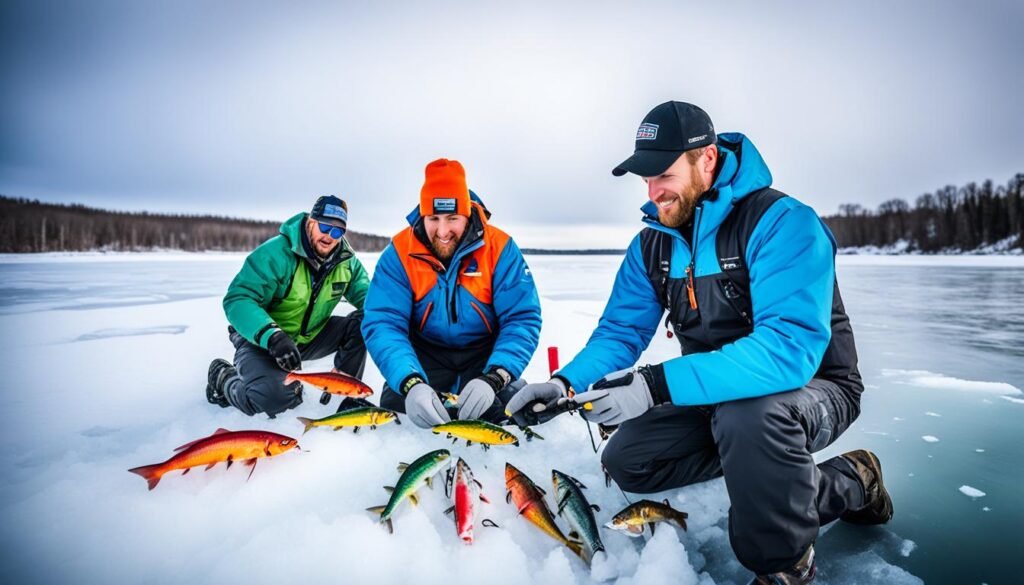
Ice fishing success depends on mastering key techniques. Jigging and lure presentation are two effective approaches. These methods can greatly improve an angler’s chances of catching fish.
Jigging and Lure Presentation
Jigging involves lifting and dropping the lure to attract fish. A natural, subtle presentation often works better than aggressive jigging. Anglers can trigger strikes by adjusting their technique based on fish behavior.
Using different bait sizes and lures can increase success. This approach targets various fish species in the same areas during early ice fishing. Try different lure colors, profiles, and sizes to find the right combination.
Reading the Ice and Locating Fish
Understanding ice conditions helps identify the best fishing spots. Fish finders can locate underwater structures and drop-offs. Early ice season offers chances to catch walleyes, pike, crappies, bluegill, and perch.
Key early ice fishing areas are typically shallow. These include points, the first break from the bank, and remnant shallow weeds. Observing other anglers and checking online forums can provide valuable insights.
Using bathymetric maps helps identify high-likelihood fishing spots. This can increase an angler’s chances of success on the ice.
| Fish Species | Ideal Depth Range | Preferred Habitat |
|---|---|---|
| Panfish (Crappie, Bluegill, Perch) | 10-15 feet | Near or in weed beds |
| Trout | Suspended in open water near underwater river channels | Weed lines and underwater points |
| Walleye | Varies | Various parts of the lake |
Mastering jigging, lure presentation, and reading the ice can boost beginner anglers’ success. Persistence and experimentation are key. These skills unlock the secrets of ice fishing and the thrill of catching fish.
“Ice fishing requires finesse and awareness. Factors like lure color, bait freshness, hook size, and line diameter can all make a difference in your success.”
Ice Safety and Precautions
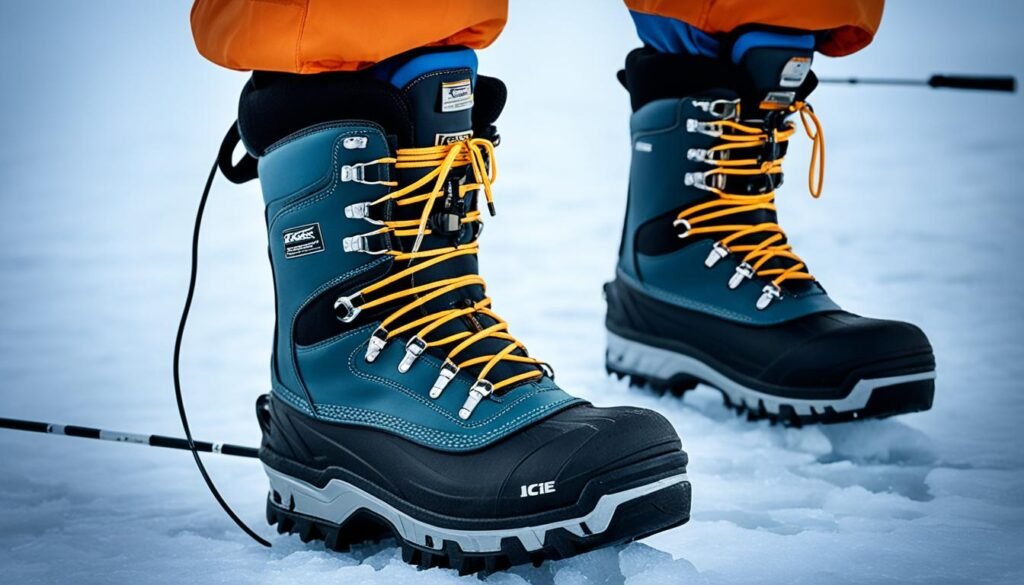
Ice anglers must prioritize safety when venturing onto frozen lakes and rivers. Checking ice thickness and conditions is crucial. The Canadian Red Cross recommends 15 cm for one person and 20 cm for a group.
Ice strength varies across water bodies. Always check thickness as you move around. Use the buddy system when testing ice with tools like axes or augers.
Checking Ice Thickness and Conditions
For sleds or snowmobiles, ice should be at least 25 cm thick. Light vehicles need 30 cm of blue ice. This should double to 60 cm for white or opaque ice.
Consider factors like water size, movement, temperature, depth, and chemical makeup. Ice color indicates strength: grey is weakest, white opaque is moderate, and blue is strongest.
Essential Ice Safety Gear
Wear a floatation suit and carry ice picks for emergencies. Ice spikes, like those in the Frabill Ice Safety Kit, are essential. A Personal Flotation Device (PFD) and throw rope are also helpful.
Layer clothing for cold: moisture-wicking base, insulating mid-layer, and waterproof outer shell. Following these safety protocols ensures a fun, worry-free ice fishing adventure.
| Ice Thickness Recommendations | Minimum Thickness |
|---|---|
| Single Person | 15 cm (6 inches) |
| Group of Skaters | 20 cm (8 inches) |
| Sled or Snowmobile | 25 cm (10 inches) |
| Light Vehicle | 30 cm (12 inches) of blue ice |
Popular Ice Fishing Destinations in Canada
Canada’s lakes and waterways offer exceptional ice fishing for all skill levels. From the Canadian Rockies to Ontario’s lakes, countless spots promise thrilling adventures. Anglers can find rewarding experiences in these stunning winter wonderlands.
Muskrat Lake in Whitewater Region is a top ice fishing spot. It’s home to unique species like lake sturgeon and longnose gar. Popular game fish include northern pike, lake trout, and smallmouth bass.
Muskrat Lake hosts the annual Cobden Ice Fishing Derby. This competitive event offers over $15,000 in prizes. It’s a must-visit for serious ice anglers.
Wawa, Algoma County in Ontario is another popular destination. Its annual derby spans three lakes. Anglers can catch lake trout, brook trout, walleye, and northern pike.
- Lake Simcoe, Canada’s ice fishing capital, offers diverse experiences. Popular catches include trout, whitefish, and yellow perch.
- Lake Nipissing provides unique overnight ice fishing in bungalows. Anglers can target northern pike, muskie, and walleye.
- The Bay of Quinte in Eastern Ontario is known for world-class walleye fishing. It’s easily accessible within city limits.
Canada’s ice fishing spots cater to all preferences. You can chase trophy lake trout or record-breaking walleye. A diverse array of freshwater species awaits in these prime locations.
Research local conditions and regulations before your trip. This ensures a memorable and rewarding ice fishing adventure in Canada’s frozen waters.
“Canada boasts thousands of lakes teeming with world-class fish, making it one of the ice fishing capitals of the world.”
Conclusion
Ice fishing in Canada is a cherished winter tradition. It offers a unique and rewarding outdoor experience. This guide provides comprehensive tips for beginners and seasoned anglers alike.
Our article covers essential elements for successful ice fishing. It includes gear selection, effective techniques, and safety priorities. With this knowledge, you can confidently prepare for your frozen adventure.
Ice fishing is a great way to embrace Canadian winters. It creates lasting memories with friends and family. Even beginners can safely venture onto the ice with proper preparation.
Safety is the top priority in ice fishing. Utilize the latest tips and resources available to enhance your experience. Bundle up, grab your gear, and get ready for an exciting day on the ice.
Immerse yourself in the charm of Canadian winters through ice fishing. With the right approach, you’ll discover the joys of this unique pastime. Happy fishing!
For an overview about Fishing for Beginners in Canada, please check this guide.
FAQs about Beginner Ice Fishing
What lures should a beginner use for ice fishing?
For beginners ice fishing in Canada, some good lure options include:
- Jigging spoons (like Swedish Pimples or Buck-Shot Rattle Spoons)
- Small jigs tipped with minnows or wax worms
- Tube jigs for perch and walleye
- Rattling lipless crankbaits
- Soft plastic swimbaits
Start with a variety of sizes and colors to see what works best. Bright colors like chartreuse, orange, and glow-in-the-dark can be effective under the ice.
What is the trick to ice fishing?
Some key tricks for successful ice fishing in Canada include:
- Stay mobile and drill multiple holes to find active fish
- Use electronics like fish finders to locate fish
- Keep your bait or lure just off the bottom
- Use subtle jigging motions – don’t overdo it
- Fish during prime times like early morning and late afternoon
- Match your bait size to the local forage
- Keep noise to a minimum to avoid spooking fish
What’s the best tip up for ice fishing?
Some popular and effective tip-ups for ice fishing in Canada include:
- HT Polar Therm Tip-Up – insulated to prevent freezing
- Frabill Pro Thermal Tip-Up – durable and reliable
- Beaver Dam Tip-Up – classic wooden design
- Clam Jason Mitchell Thermal Tip-Up – easy to use and transport
- Eskimo Rocket Tip-Up – compact and wind-resistant
Choose a tip-up that’s easy to set up and visible in snowy conditions.
What is the best depth to ice fish for pike?
The best depth for ice fishing northern pike in Canada typically ranges from 5 to 15 feet of water. However, pike can be found at various depths depending on the lake and time of season:
- Early ice: Focus on shallow bays in 5-10 feet of water
- Mid-winter: Try 10-20 feet near drop-offs or weed edges
- Late ice: Pike may move shallower again, often in 5-15 feet
Always check local regulations and ice thickness for safety before venturing out. Experiment with different depths until you find active fish.
What essential gear do I need for ice fishing as a beginner?
Beginners need a medium or light-action ice fishing rod and reel. You’ll want 6-8 lb test line and effective lures like 1/8 oz jigs. An ice auger and portable shelter are also crucial.
What are some important ice fishing techniques I should learn?
Master the jigging method by lifting and dropping the lure to entice strikes. Present the lure naturally and subtly for better success. Use fish finders to locate underwater structures and find the best spots.
How can I ensure my ice fishing experience is safe?
Always check ice thickness before venturing out. A minimum of 4 inches of clear, solid ice is needed for foot traffic. Wear essential safety gear like a floatation suit and ice picks.
Where are some of the best ice fishing destinations in Canada?
Northwestern Ontario lakes are popular for ice fishing. The Bay of Quinte in Eastern Ontario is another great spot. Alberta and British Columbia offer numerous lakes and rivers for anglers.
These regions have a variety of species, including walleye, perch, trout, and pike.
What regulations should I be aware of when ice fishing in Canada?
Research local regulations for your chosen ice fishing area. Understand licensing requirements, season dates, and possession limits. Be aware of any restrictions set by provincial or territorial authorities.
Source Links
- https://www.outdoorcanada.ca/expert-ice-fishing-tips/
- https://truenorthwilds.com/ice-fishing-beginners/
- https://northernontario.travel/sunset-country/beginners-guide-ice-fishing-canada
- https://misspursuit.com/an-introduction-to-ice-fishing-for-beginners/
- https://www.amazon.ca/Beginners-Guide-Ice-Fishing-Equipment/dp/1447453808
- https://lestresorsderable.com/en/blog/post/practice-ice-fishing-in-canada.html
- https://captainexperiences.com/blog/ice-fishing-gear-for-beginners
- https://www.outdoorhub.com/7-ice-fishing-essentials-beginners/
- https://www.wired2fish.com/ice-fishing/ice-fishing-essential-gear-guide
- https://www.lurenet.com/blog/6-keys-to-early-ice-fishing-success/
- https://www.themeateater.com/fish/ice-fishing/4-habits-of-highly-successful-ice-anglers
- https://mackslure.com/blogs/mack-attack/ice-fishing-how-to-locate-fish-and-effective-jigging-techniques
- https://www.destinationontario.com/en-ca/articles/ice-safety-3-steps-could-save-your-life
- https://onthewater.com/ice-fishing-safety-tips
- https://1source.basspro.com/news-tips/ice-fishing/36297/ice-fishing-101-beginner-tips-and-essential-equipment-memorable-adventure
- https://www.pembrokeobserver.com/sports/local-sports/muskrat-lake-among-the-9-best-ice-fishing-destinations-in-canada-for-2024
- https://www.swimdrinkfish.ca/blog/7-great-ontario-ice-fishing-spots
- https://fishncanada.com/top-5-ontario-ice-fishing-destinations/
- https://fishncanada.com/fishn-canadas-guide-to-ice-safety/
- https://www.razrpowr.com/post/why-you-should-try-ice-fishing
- https://pourvoiriedulacberval.com/en/ice-fishing-tips-advice/

